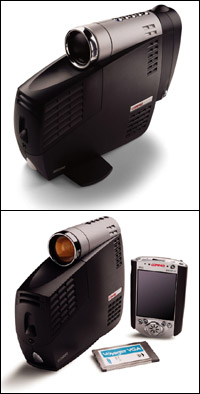|
C77: Can you give us an example of innovation that has come from the strategic design team?
RM: The iPAQ Pocket PC is one example of how we have
used an "off road" process to push the innovation envelope. Over
the previous year Compaq had entered the rapidly expanding hand-held
computer, or PDA, market. As is common with new technology programs,
we had partnered with a manufacturer in the Far East to produce
several Compaq AERO branded PDA devices. Our design freedom was
restricted to basically "skinning" an existing mechanical platform.
While this was an efficient and cost effective way of entering
a new market, it was not going to provide us with a product that
could compete with Palm's wildly successful PDA.
In the spring of 1999 we decided to break out of
the normal development process with the intent of designing a
"Palm killer" PDA based on the next generation Pocket PC OS that
was under development at Microsoft. In an effort to remove some
of the day-to-day interruptions and gain different perspectives,
we held a strategic design "summit" in an offsite location. We
chose the Broadmoor Hotel in Colorado Springs, CO as a halfway
point for members of the proposed team. We included Compaq engineers
and marketing personnel, manufacturing partners from Taiwan, software
experts from Microsoft, and several of our internal design team,
as well as members from Astro Design Studios, one of our regular
design consultancy partners
We spent the first day working through a series
of presentations by each of the disciplines outlining the target
market, available technologies, manufacturing parameters, design
trends and competitive feature sets. On the last day of the meeting,
one of the more interesting exercises (and, as it turned out,
one of the most profitable) involved breaking up into teams and
participating in an exercise to define a group of target customers
that we were NOT selling to at the moment. The teams developed
lifestyle profiles on each of these individuals, complete with
fictional names and a wants / needs list. In the end, we settled
on eight profiles with names like: Contractor Bob, Gena the Grad
Student, June the Soccer Mom, and Mr. Lee the corporate executive.
Armed with all this data and some target customers, the design
teams returned to the studios for a round of concept generation.
A decision was made to develop product concepts
for each of the eight individuals, independently of the other
seven. In other words, attempt to design a device that would be
appealing for Contractor Bob, a job site foreman, without worrying
about a broader appeal. After several weeks of exploration, the
process yielded eight entirely different solutions, with appearance
and various features and functions specific to the individual
for which it was designed.
A meeting with the original team remembers was held
at the Compaq Campus in Houston. After reviewing each of the designs
we were confronted with the expected dilemma. Each of the concepts
had appealing attributes, but given the nature of our delivery
model and limited resources, we would be forced to reduce the
choices down to one direction, even if it was made up of a combination
of several devices.
At one point during the subsequent discussions,
we were focused on the "Contractor Bob" concept, which sported
a sleek metallic finish and a "rubberized" grip area reminiscent
of precision power tools. In fact, we had dubbed this concept
"an information power tool." A question was asked concerning how
the rubberized area was molded, and whether or not it was removable.
In this particular concept the design intent was a co-molded approach,
and the piece was not intended to be removed. However, after further
discussion, we realized that the idea of a removable "jacket"
or "sleeve" was a powerful concept that would allow us to address
the personalization of the device. This is similar in concept
to the way cell phone companies use snap on covers to change the
appearance of the device. Many of the other seven concepts sported
colors and textures that would be appealing to teens, females,
and/or professionals, and this concept would allow us to address
them all with one base unit and optional jackets.
Even though the personalization aspect of this highly
personal device was reason enough to go with the concept of a
removable jacket, the real innovation was yet to come. Within
moments of discussing the concept of a removable jacket a leap
was made to incorporate functionality into the jackets. We quickly
realized the power of the idea when we began discussing all the
various devices we could build into jackets, which would be accessible
through a bus connection from the main unit. We could foresee
the integration of Cell Phones, Bar Code Scanners, MP3 Players,
GPS devices, as well as the usual memory and battery expansion
options.
Even though this was suppose to be an advanced concept
exercise, management was so intrigued with the concept, that a
decision was made to accelerate development, and introduce the
unit at the same time as Microsoft planned to unveil the new OS.
So, after many months of hard work, the team introduced the iPAQ
Pocket PC to unparalleled press and media attention. The product
has won more industry awards than any product in Compaq history.
But as they say "proof is in the bottom-line:" The iPAQ Pocket
PC quickly ramped to over 100,000 units a month, outselling our
initial forecast by over 10 times. The final victory came in the
second quarter of 2001 when the product overtook the number one
revenue spot from Palm in the PDA marketplace. Recently, we announced
the next generation of the Pocket PC, the iPAQ 3800 series, which
incorporates an SD slot and optional bluetooth wireless. However,
the unit is still backwards compatible with the expansion jackets
that were developed over the course of the last year by Compaq
and numerous 3rd party suppliers.
|
|



|